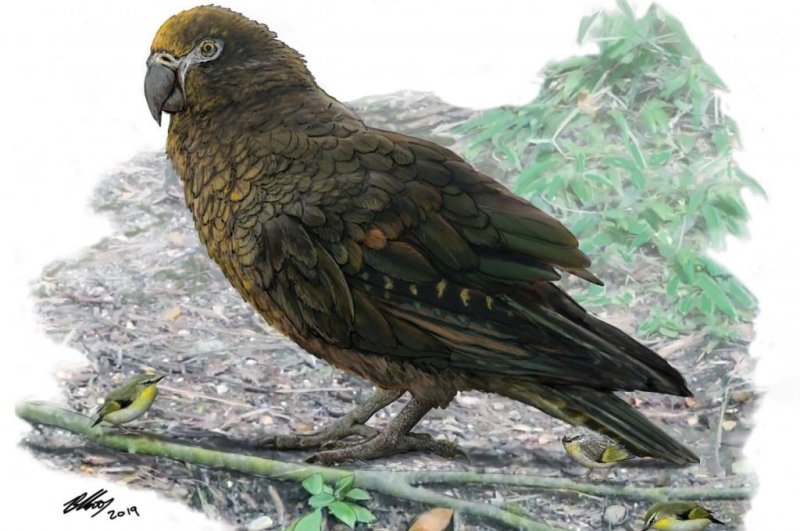An illustration of the giant parrot shows the massive bird dwarfing the New Zealand wrens scurrying below on the forest floor. Photo by Brian Choo/Flinders University
Aug. 7 (UPI) -- Scientists didn't set out to unearth the biggest parrot in history, but that's what they what found.
Paleontologists found the remains of the giant parrot in 19-million-year-old deposits near St. Bathans in Central Otago, New Zealand. The research team named the new species Heracles inexpectatus; they described the record-setting bird in a paper published Wednesday in the journal Biology Letters.
The massive parrot stood more than three feet tall and its giant beak could crack most types of food, scientists surmised.
The newly named species hails from the Miocene period. Fossil-rich deposits from the period hold the secrets of animal evolution in the wake of the dinosaur's disappearance.
"We wanted any remains of birds and associated terrestrial animals because the St. Bathans fauna is the only one giving us insight into the period from the end of dinosaurs to about 1 million years ago," Trevor Worthy, an associate professor at Flinders University in Australia, told UPI. "It is thus a hugely significant fauna for understanding the evolution of New Zealand animals."
Scientists have found a variety of extinct giant bird species across the globe, but until now, researchers had yet to uncover a giant parrot species.
The new species was roughly the size of the famous dodo of the Mauritius. Scientists suggest the species belonged to a primitive group of parrots from New Zealand, of which the endangered kakapo is a member.
With the discovery of Heracles, scientists can paint a rich picture of life during the Miocene on New Zealand.
"Heracles lived with some 40 other species of birds at least in the warm subtropical forests and around the lake," Worthy said. "It was likely flightless and certainly spent most time on the ground where it walked about with at least a couple moa species and a similar sized adzebill."
According to Worthy, the species foraged for fruits and seeds dropped by the many lakeside trees and plants.
"Heracles may also have preyed on small animals that it could dig out of logs or even snacked on dead or dying moa," Worthy said.
Many of the birds that Heracles lived alongside survived for millions years, disappearing only after the arrival of humans, but the giant parrot didn't last as long.
"Heracles and the diversity of parrots and pigeons was likely lost about 13 to 12 million years ago," Worthy said, "when there was an abrupt climate cooling of about 8 degrees Celsius and most of the warmth-loving plants and hence most of the berry and fruiting trees were lost."















